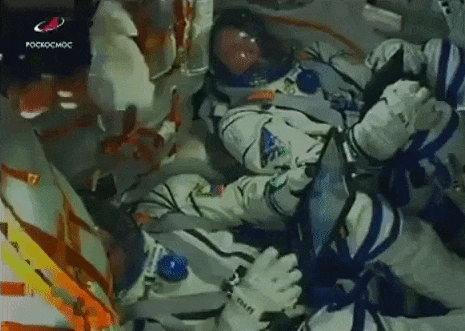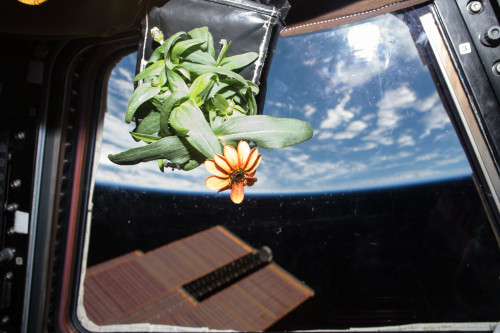Soyuz MS-10 Experiences Launch Anomaly; Crew Aborts To Safe Landing.

Soyuz MS-10 experiences launch anomaly; crew aborts to safe landing.
One of Russia’s most reliable launchers experienced a rare, in-flight anomaly earlier this morning, forcing the two-man crew of Soyuz MS-10 to abort the mission.
Following a normal liftoff at 4:40am EST (2:40pm local time), a malfunction in the Soyuz FG rocket two minutes into the flight forced Expedition 57 crewmembers Alexey Ovchinin and Nick Hague to abort a manual abort profile. The anomaly occurred immediately following the separation of the rocket’s four strap-on boosters and jettisoning of the Launch Escape System. However, the protective fairing covering the spacecraft during flight through the thick atmosphere was still on, and solid rocket motors attached to the fairing pulled the crew capsule away from the failing booster. Following a ballistic trajectory through the upper atmosphere, the Soyuz’s Descent module separated from the Orbital Module and payload fairing and descended to a safe landing 20 kilometers east of Zezkezhan, Kazakhstan, 34 minutes after launch. Roscosmos reported that the crewmembers experienced around seven times the force of gravity, or 7G’s, during their abort.
Recovery forces reached the landing site immediately following touchdown. Both astronauts were reported to be in good health following their ordeal, and returned to their families at the Baikonur launch site around six hours after liftoff.

Recovery forces at the Soyuz MS-10 emergency landing site. Source: Ruptly.

Soyuz MS-10 crewmembers Alexey Ovchinin and Nick Hague embrace their families following their return to the Baikonur Cosmodrome after today’s launch mishap. Credit: NASA/Bill Ingalls. This marks the first crewed launch mishap of the International Space Station program, the first crewed launch mishap since the Challenger disaster in 1986, and the first crewed Soyuz launch malfunction since Soyuz T-10 in 1983.
That incident saw the two-man crew of Vladimir Titov and Gennady Strekalov abort away from their exploding rocket shortly before its scheduled liftoff time. While no cause of the mishap is currently known, Russian authorities have begun an investigation of the incident and have temporarily grounded all future Soyuz flights. The current three-member crew of Expedition 57 is slated to return to Earth December 13, followed by the launch of Expedition 58 December 20. Following today’s anomaly, it is unclear whether Expedition 57 will remain on orbit longer, or when the next crew will launch to the station. Expedition 57 is able to remain on orbit until early January, when their Soyuz reaches its certified orbital lifetime.

Expedition 57 commander Alexander Gerst captured this image of the Soyuz MS-10 launch from the International Space Station. The anomalous nature of the launch is evidenced by multiple points of light along the ascent path. Source: NASA. Watch NASA TV coverage of the Soyuz MS-10 launch below.
P/c: NASA.
More Posts from Fillthevoid-with-space and Others



Take a moment, look outside your window. 🌷🌼
Today is the #FirstDayOfSpring in the Northern Hemisphere, also known as the vernal equinox.
#DYK Earth’s tilted axis causes the season? Throughout the year, different parts of Earth receive the Sun’s most direct rays. So, when the North Pole tilts toward the Sun, it’s summer in the Northern Hemisphere. And when the South Pole tilts toward the Sun, it’s winter in the Northern Hemisphere.
These images are of Zinnias. They are part of the flowering crop experiment that began aboard the International Space Station on Nov. 16, 2015, when NASA astronaut Kjell Lindgren activated the Veggie system and its rooting “pillows” containing zinnia seeds.
Make sure to follow us on Tumblr for your regular dose of space: http://nasa.tumblr.com.

Space Station Crew Members Walk In Space to Connect Docking Adapter Component
Outside the International Space Station, Expedition 50 Commander Shane Kimbrough and Flight Engineer Peggy Whitson of NASA conducted a spacewalk March 30 to connect the newly relocated Pressurized Mating Adapter-3 (PMA-3) to the Harmony module in preparation for the delivery of an International Docking Adapter to PMA-3 to which U.S. commercial crew spacecraft will link up to in the years ahead. The mating adapter was robotically relocated from the port side of the Tranquility module to Harmony March 26 by ground controllers. Kimbrough and Whitson also installed the second of two upgraded computer relay boxes on the station’s truss and installed shields and covers over PMA-3 and the vacant port on Tranquility to which the PMA had been attached. It was the 199th spacewalk in support of space station assembly and maintenance, the sixth in Kimbrough’s career and the eighth for Whitson, who surpassed NASA’s Suni Williams for most spacewalks and most aggregate spacewalking time by a female.

Oh my gosh this is incredibly exciting! Imagine combining them with a Star Wars LEGO set...
One more reblog! Seriously, hit me up by Friday, April 14th if you have strong opinions about what I delve into next, research-wise. I’m ready to get back to it. You can tweet me (@HDandtheVoid) or comment here on tumblr maybe? I have anonymous on, no worries. :)

The first episode is here! I have never done this before and right now, I’m planning to put up a podcast every two weeks.
Below the cut is some elaboration on the episode itself, including my sources, music credits, a glossary, and a transcript (not an exact record of this episode, but it’s the script I was working with and it’s both conversational and also a little less rambling than what I actually said). I’m on Twitter now, too: @HDandtheVoid. I don’t know what I’ll put there yet except maybe fun little facts and, of course, notifications on when an episode goes up.
Let me know what you think of this episode, let me know what you think I should research next*, tell me a fun space fact… anything’s helpful at this point!
*(Move fast if you feel strongly about what I research next, though, cuz I have to get it done by April 24th—I don’t mention it in the podcast but this is me telling you now so I am held accountable; April 24th is the next podcast.)
Keep reading
I talked about spaghettification but someone did one better and made a dang cute comic about it!






Starry Greetings!
This week’s comic: Spaghettification
https://www.youtube.com/watch?v=OGn_w-3pjMc
http://science.howstuffworks.com/science-vs-myth/what-if/what-if-fell-into-black-hole2.htm
Solar System: Things to Know This Week
Like sailors of old, the Cassini mission team fondly thinks of the spacecraft as “she." On April 22, she begins her Grand Finale, a spectacular end game—22 daring dives between the planet’s atmosphere and innermost rings. Here are 10 things to know about her Grand Finale.

1. She’s Broadcasting Live This Week
On Tuesday, April 4 at 3 p.m. EDT (noon PDT), At Jet Propulsion Laboratory, the Cassini team host a news briefing to discuss the mission’s Grand Finale.
Tune in Tuesday: youtube.com/nasajpl/live

2. She’s Powered in Part By … Titan
Cassini left Earth with less than 1/30th of the propellant needed to power all her adventures at Saturn. The navigation team used the gravity of Saturn’s giant moon Titan to change course and extend the spacecraft’s exploration of Saturn. Titan also provides the gravity assist to push Cassini into its final orbits.
More on Cassini’s navigation: saturn.jpl.nasa.gov/mission/spacecraft/navigation/

3. She’s a Robot
Cassini is an orbiter that was named for 18th century astronomer Giovanni Domenico Cassini. She was designed to be captured by Saturn’s gravity and then explore it in detail with a suite of 12 powerful science instruments.
More on the Spacecraft: saturn.jpl.nasa.gov/mission/spacecraft/cassini-orbiter/

4. She Brought a Friend to Saturn
Cassini carried the European Space Agency’s Huygens Probe, which in 2005 descended through Titan’s thick, perpetual clouds and made the most distant landing to date in our solar system.
More on Huygens: saturn.jpl.nasa.gov/mission/spacecraft/huygens-probe/

5. She’s a Great Photographer
Your mobile phone likely captures dozens of megapixels in images. Cassini, using 1990s technology closer to one megapixel cameras, has returned some of the most stunning images in the history of solar system exploration.
Cassini Hall of Fame Images: go.nasa.gov/2oec6H2 More on Cassini’s Cameras: saturn.jpl.nasa.gov/imaging-science-subsystem/

6. She’s an Inspiration
Those great images have inspired artist’s and amateur image processors to create truly fantastic imagery inspired by the beauty of Saturn. Feeling inspired? There’s still time to share your Cassini-inspired art with us.
Cassini Inspires Campaign: saturn.jpl.nasa.gov/mission/cassiniinspires/

7. She’s Got a Long History
Two decades is a long time to live in the harsh environment of outer space (respect to the fast-approaching 40-year-old twin Voyager spacecraft). Launched in 1997, Cassini logged a lot of milestones over the years.
Explore the Cassini Timeline: saturn.jpl.nasa.gov/the-journey/timeline/

8. She Keeps a Diary
And, you can read it. Week after week going back to 1997, Cassini’s adventures, discoveries and status have been chronicled in the mission’s weekly significant events report.
Read It: https://saturn.jpl.nasa.gov/news/?topic=121

9. She’s Got a Fancy New App
Cassini was the prototype for NASA’s Eyes on the Solar System 3-D visualization software, so it’s fitting the latest Cassini module in the free, downloadable software is the most detailed, elaborate visualization of any mission to date.
Fly the Mission - Start to Finish: http://eyes.nasa.gov/cassini

10. She’s Going Out in a Blaze of Glory
In addition to all the new information from 22 orbits in unexplored space, Cassini’s engineers reprogrammed the spacecraft to send back details about Saturn’s atmosphere to the very last second before the giant planet swallows her up on Sept. 15, 2017.
More on the Grand Finale: saturn.jpl.nasa.gov/grandfinale
Discover more lists of 10 things to know about our solar system HERE.
Make sure to follow us on Tumblr for your regular dose of space: http://nasa.tumblr.com

The last look before her descent in fire…

The first episode is here! I have never done this before and right now, I’m planning to put up a podcast every two weeks.
Below the cut is some elaboration on the episode itself, including my sources, music credits, a glossary, and a transcript (not an exact record of this episode, but it’s the script I was working with and it’s both conversational and also a little less rambling than what I actually said). I’m on Twitter now, too: @HDandtheVoid. I don’t know what I’ll put there yet except maybe fun little facts and, of course, notifications on when an episode goes up.
Let me know what you think of this episode, let me know what you think I should research next*, tell me a fun space fact… anything’s helpful at this point!
*(Move fast if you feel strongly about what I research next, though, cuz I have to get it done by April 24th—I don’t mention it in the podcast but this is me telling you now so I am held accountable; April 24th is the next podcast.)
Glossary:
cosmic microwave background radiation—the electromagnetic radiation left over from the time of recombination in Big Bang cosmology.
cosmology—the study of the properties of our universe as a whole.
heliacal rising—when a star or constellation rises at the same time or just before the sun.
parapegma—a list of star rising times.
retrograde—the apparent motion of a planet in a direction opposite to that of other bodies within its system, as observed from a particular vantage point.
sidereal year—the time required for the earth to complete an orbit of the sun relative to the stars.
star catalog—an astronomical catalog that lists stars.
star chart/map—A star chart or star map is a map of the night sky. Astronomers divide these into grids to use them more easily. They are used to identify and locate astronomical objects such as stars, constellations, and galaxies.
tropical year—the interval at which seasons repeat and the basis for the calendar year.
Wilkinson Microwave Anisotropy Probe—a spacecraft operating from 2001 to 2010 which measured temperature differences in the cosmic microwave background radiation leftover from the Big Bang. (I said ‘anistropy’ in the podcast, whoops)
Script/Transcript (It’s not exactly what I said, but it’s what I was going off of. It’s conversational and it’s less rambly than what I actually said)
Sources:
Cosmic microwave background radiation info
More Big Bang info
Timeline of the Big Bang
Babylonian constellation/zodiac list
Babylonian star catalog
Retrograde motion
Evans, James. The History and Practice of Ancient Astronomy. Oxford UP: New York, 1998.
...and class notes from a class on Ancient Astronomy I took with Prof. James Evans.
My argument for using Wikipedia is that it is shockingly accurate when it comes to ancient material. I’m going to try to stick to academic and government sources though.
Intro Music: ‘Better Times Will Come’ by No Luck Club off their album Prosperity
Outro Music: ‘Fields of Russia’ by Mutefish off their album On Draught
-
 catseye-among-aggies liked this · 1 year ago
catseye-among-aggies liked this · 1 year ago -
 omlakalchoge liked this · 1 year ago
omlakalchoge liked this · 1 year ago -
 may2217 liked this · 4 years ago
may2217 liked this · 4 years ago -
 bepacb liked this · 4 years ago
bepacb liked this · 4 years ago -
 okyanus-world liked this · 4 years ago
okyanus-world liked this · 4 years ago -
 mechozx12 liked this · 4 years ago
mechozx12 liked this · 4 years ago -
 shaman-chant reblogged this · 5 years ago
shaman-chant reblogged this · 5 years ago -
 shaman-chant liked this · 5 years ago
shaman-chant liked this · 5 years ago -
 alexstark1806 liked this · 5 years ago
alexstark1806 liked this · 5 years ago -
 citrronnade liked this · 5 years ago
citrronnade liked this · 5 years ago -
 urlocalmilf liked this · 5 years ago
urlocalmilf liked this · 5 years ago -
 ashtaarot reblogged this · 5 years ago
ashtaarot reblogged this · 5 years ago -
 draconusumbra69 liked this · 6 years ago
draconusumbra69 liked this · 6 years ago -
 bikerdude51 liked this · 6 years ago
bikerdude51 liked this · 6 years ago -
 academic-sorceress liked this · 6 years ago
academic-sorceress liked this · 6 years ago -
 vladdonskoy-blog liked this · 6 years ago
vladdonskoy-blog liked this · 6 years ago -
 unmaskedrider liked this · 6 years ago
unmaskedrider liked this · 6 years ago -
 michael-rocket liked this · 6 years ago
michael-rocket liked this · 6 years ago -
 vaguely-none liked this · 6 years ago
vaguely-none liked this · 6 years ago -
 streamofconsciousness90 reblogged this · 6 years ago
streamofconsciousness90 reblogged this · 6 years ago -
 unhealthyobsessionwithspace-blog liked this · 6 years ago
unhealthyobsessionwithspace-blog liked this · 6 years ago
A podcast project to fill the space in my heart and my time that used to be filled with academic research. In 2018, that space gets filled with... MORE SPACE! Cheerfully researched, painstakingly edited, informal as hell, definitely worth everyone's time.
243 posts









